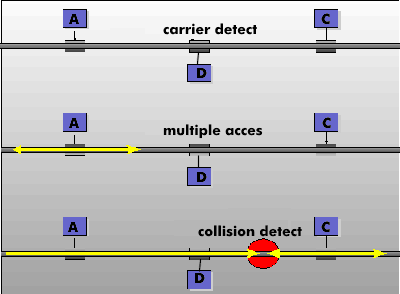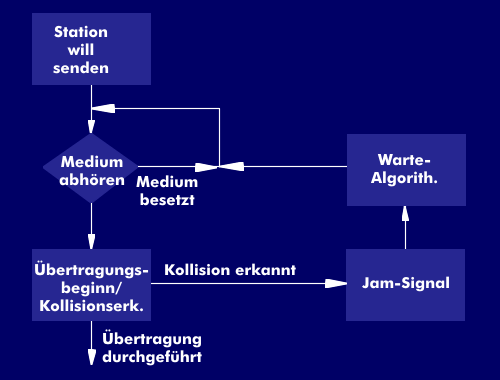carrier sense multiple access with collision detection (Ethernet) (CSMA/CD)
CSMA/ CD(Carrier Sense Multiple Access with Collision Detection) is an access method with line scanning and collision detection. This method works according to the random access method and regulates access to the transmission medium in local area networks( LAN) in bus topology.
There are several CSMA methods, of which CSMSA/CD works with collision detection and forms the basic technology for Ethernet. In this method, channel allocation is regulated by the fact that all stations willing to transmit monitor the transmission medium ( carrier sensing, listen before talking) and start transmitting when the transmission medium is free.
Transmission takes place at the earliest after a time interval, the Interframe Gap( IFG), after the medium becomes free. If the channel is busy, the channel continues to be monitored until it is detected as unbusy. The states of being occupied or unoccupied are determined by carrier detection from the level changeson the transmission medium. If a level change occurs after a specified bit time, a carrier signal is on the cable; in all other cases, the transmission medium is considered unoccupied.
During transmission, the channel continues to be listened to (Listen While Talking). If a second station starts transmitting at the same time, the data of both stations will collide at one point of the network, the signal level on the transmission medium will increase; this is called the collision level. Since all transmitting stations constantly monitor the transmission level on the medium, when a collision is detected, these stations immediately abort the transmission and send a special jamming signal, the jam signal, on the channel. After sending out the jamming signal, the stations wait for a certain time(backoff) and then start CSMA transmission again, beginning with the first step, listening to the medium (carrier sensing).
The probability of collisions
The probability of collisions increases with the number of network nodes and the length of the LAN segment in question. In fact, as the length increases, the propagation time between the two stations farthest from each other increases, which directly affects the detection of a collision. Both parameters, the number of stations and the segment length, determine the performance limit of CSMA/CD networks, i.e. of classical Ethernet. The third parameter that directly affects the efficiency of Ethernet is the frame length. The shorter the packet length, the lower the performance.


